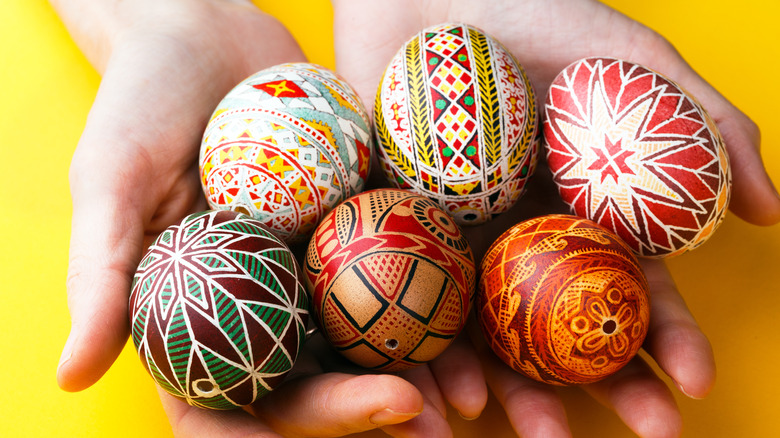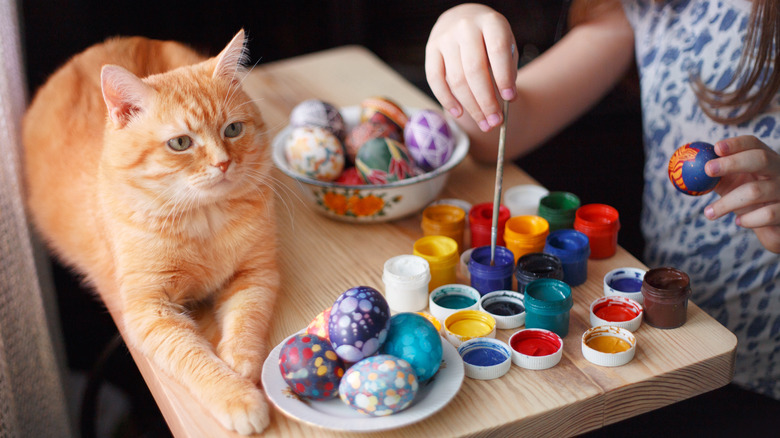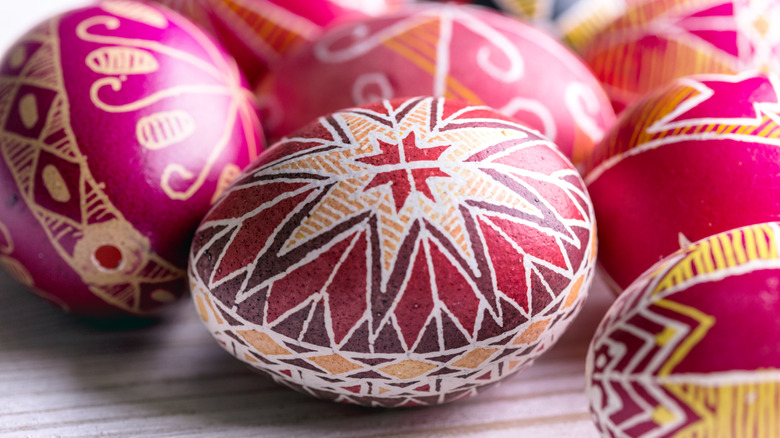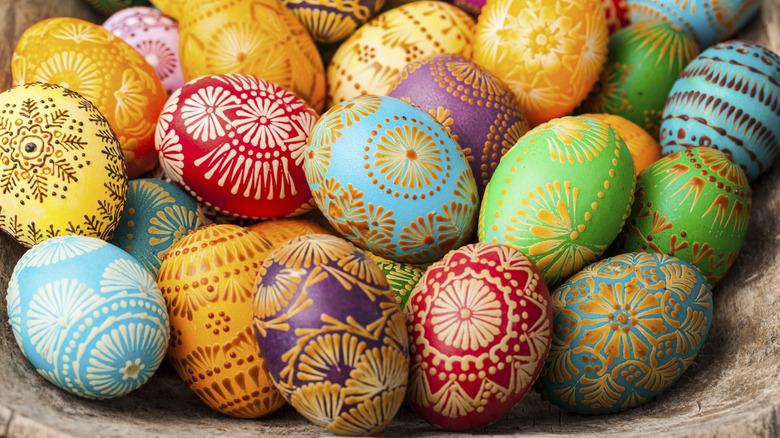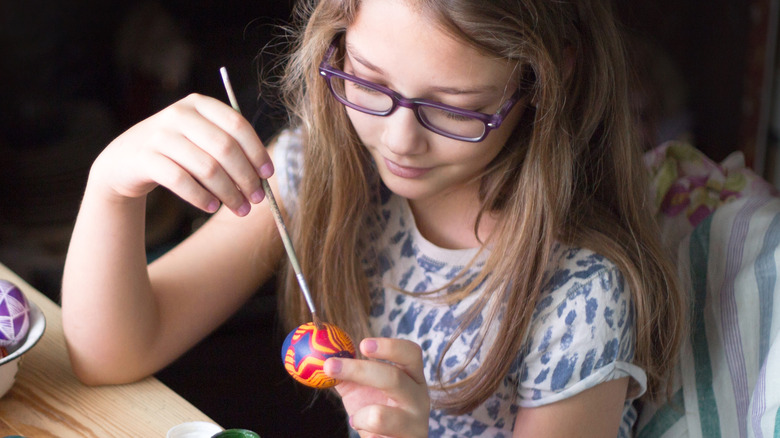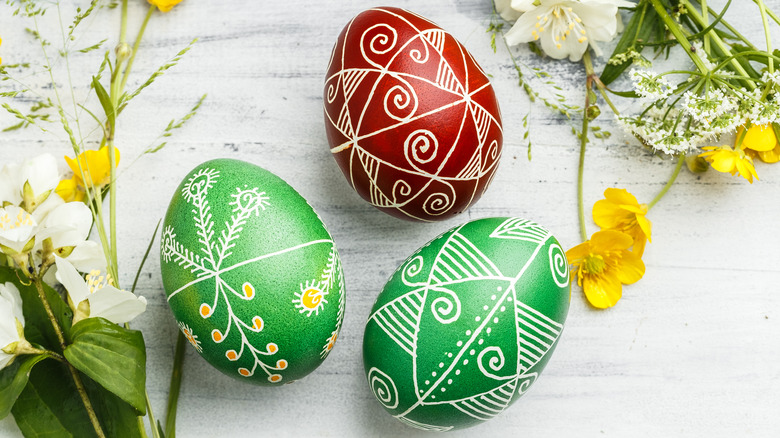The Origin Of Ukraine's Intricately Decorated Easter Eggs
Anyone who has ever celebrated Easter — secular and religious alike — has likely decorated an Easter egg to mark the occasion. This practice has deep roots in both Christian and pre-Christian tradition. One area of the world where Easter egg decoration is particularly important is Ukraine, with a special technique for decorating the egg known as "pysanka," from the Ukrainian verb for writing, pysaty. In Ukraine, pysanka, plural pysanky, is much more than just dipping hard-boiled eggs in some food coloring, like most of us did when we were children. Pysanka, instead, is an intensive, meticulous, and ancient craft producing intricate and beautiful designs. The tradition also has a deep and important place in Ukrainian culture, per Ukrainian People.
Pysanka in this part of the world stretches back to pre-Christian and pagan times. Pysanka was practiced by women and girls, and many of the designs still used today hold significance in pre-Slavic cultures. Over the centuries, pysanky eggs have come to represent fertility, rebirth, and a blessing to the harvest, making the practice a natural fit for modern Easter holiday celebrations. At first, pysanky eggs held nature-based iconography, but as the influence of Christianity spread, Christian symbology like crosses and fish were soon added, as House Beautiful explains. Pysanky eggs, otherwise, can feature a number of different motifs, and each one has its own special meaning.
Geometric symbolism and pysanky eggs
Symbols and meaning in pysanka have changed over the millennia, and these days, much of the religious and spiritual significance has shifted to reflect a more modern, science-based, or just decorative view of the world and the craft of pysanky. Pysanka nearly died out when Ukraine fell under the sway of the Soviet Union, as it was seen to be a religious tradition. More than all others, though, geometric figures are perhaps the most common kind of pysanka design, and they're believed to date all the way back to Paleolithic cultures in the Ukrainian region.
Geometric pysanky egg designs are typically lines, squares, or some other kind of shape. Triangles symbolize rain, an important portent for good harvest, while dots represent seeds, and quadrilaterals stand in for plowed fields. These are just a few of the many examples of the part geometry plays in pysanka. Another important geometric motif is the berehynia, a curly-shaped goddess symbol used as a harvest blessing, among other purposes. There are also eternity bands, representing immortality, as well as water and waves used for rain blessings, as Ukrainian People explains.
The Christian influence on pysanky eggs
As the Christian religion spread throughout the world, various symbols common to Christianity were integrated into pysanky eggs. Most often, this took the form of a church-like shape with a steeple, but crosses also show up in post-Christian pysanka. Cross-like designs had some significance in the Ukrainian region even prior to the Christian church. There's also a sieve, a sun symbol, and a triangle with a circle in the center expressing the ever present and always watching eye of God. This motif has became increasingly common in the post-Christian Ukrainian region.
The most common motifs in pysanky eggs are based in nature, though. These can include flowers, trees, and even a flower design called "vazon." The tree of life most often shows up as a pine tree with two deer on either side. The "berehynia," or goddess symbol, often has branches representing the many arms of the mother goddess. Although less common than other types of nature-based symbols used in pysanky, fruit symbols such as currants and grapes are sometimes used to symbolize abundance. The sun motif was considered especially important as it protected from illness, but also came to represent the Christian God's love, among other meanings, according to Ukrainian People.
The importance of color in pysanky eggs
Other symbols and motifs common in pysanky eggs include man-made agricultural implements such as ladders and sieves, as well as animals like birds, fish, and insects, each with its own special meaning and significance in both ancient and modern Ukrainian culture. Spiders and spider webs, just as one example, represent perseverance, while fish — an already important symbol in Ukraine prior to the arrival of Christianity — have shifted to represent Christ, as they have in many other Christian cultures throughout the world.
The most important of all aspects in pysanky design, however, is probably color. Each color has its own special meaning, and some colors combine for added significance, such as black and white representing a period of mourning, or just four or more colors reflecting the good cheer or abundance a family has experienced throughout the year. Otherwise, red is perhaps the most important color of all in pysanky, representing life-giving blood, but also love and marriage, among other interpretations. Black represents worlds beyond our understanding that might be thought of like heaven and hell (via Ukrainian People).
How are pysanky eggs made?
Regardless of what the design on a pysanky egg looks like, the method to make one remains much the same, per The Ukrainian Museum. First of all, making pysanky eggs was performed alone by women and girls in secret, away from any possible stranger who might curse the egg, and always with a fertilized chicken eggs, linking the delicate practice even more closely with fertility, the harvest, and birth. Pysanky eggs were believed to be sacred, and to even possess magical powers.
Traditionally, pysanky eggs are decorated using what's called a batik method, similar to how fabrics are sometimes decorated, according to House Beautiful. First the egg is covered in wax, traditionally beeswax, which is allowed to harden. Then, an implement called a kistka is used by the artisan to draw the design on the delicate wax-covered shell. Colors are added using natural dyes. These days, pysanky eggs are often made from wood, giving them added longevity all throughout the year. Actual organic chicken eggs, naturally, must be disposed of before they begin to rot, mildew, and smell once the Easter festivities conclude.
Pysanky eggs today
Today, pysanky eggs are popular all throughout the world, while they're considered a treasured traditional folk art in Ukraine. Many tips and tutorials to make your own DIY pysanky eggs for Easter season exist online from websites like Martha Stewart, among many others. Those deciding to try pysanka for themselves should choose their eggs carefully, looking for smooth and uncracked shells. There should also be no transparent spots, which can sometimes indicate a weak part of the egg. One tip to solve the rotten egg problem is to hollow out the shell before you begin.
Then, simply use a pencil and draw your design freehand, or use any number of free stencils available online to guide your creation. These can be traditional pysanky symbols or, instead, develop some of your own, updating the practice for a whole new generation. Just as with traditional pysanka eggs, modern homemade pysanky is covered in beeswax and then natural dyes. There's more to the process than this, and getting it right does take some practice. Most of the supplies necessary to try it for yourself — including kistka — are available at local craft stores. What's for certain, with a little patience and perseverance, it's possible to add pysanky eggs to your next Easter celebration.
